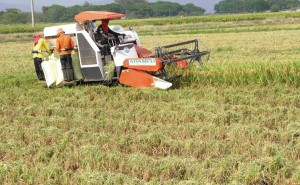
FARMERS call this machine “halimaw” or beast, blaming mechanization for loss of income. ANSELMO ROQUE/INQUIRER CENTRAL LUZON
SCIENCE CITY OF MUÑOZ, Philippines—A government farm mechanization program, which failed in the 1970s, has been reintroduced and supported by public and private funds as Malacañang tries to reinvigorate the food industry.
But farm workers are unimpressed. A few who spoke to the Inquirer said mechanization made them lose income during martial law.
According to the Philippine Center for Postharvest Development and Mechanization (PhilMech), four provinces, among them top rice producers, have achieved full mechanization at a scale that is much higher than the national average of 1.52 horsepower per hectare (hp/ha).
Pangasinan tops the list with 12.41 hp/ha., followed by Kalinga with 7.41 hp/ha, Isabela with 9.52 hp/ha and Nueva Ecija with 9.13 hp/ha.
Horsepower per hectare refers to the amount of energy spent by a machine as it is used on a farm.
When mechanization was introduced in the 1970s, the country was suddenly plagued by the world oil price crisis, and the program was abandoned because of the steep price for fuel needed to keep the machines running.
In 2011, the Department of Agriculture (DA) launched the government’s farm mechanization program, with a funding of P6 billion. The DA infused more funds recently to sustain the program until 2016, “to further increase the productivity and incomes of small farmers,” according to a PhilMech report.
When he presided over the program’s roadshow in 2011, Agriculture Secretary Proceso Alcala said the DA national rice program allotted P1 billion for the first year of the mechanization program, P2.6 billion for the second year, and another P2.4 billion for 2013.
The funds helped purchase machines and equipment for distribution to farmers’ groups and cooperatives, irrigators’ associations and local governments.
The program gives farmers access to such machines like rice drum seeders, seed cleaners, rice transplanters, power tillers with trailers, hand tractors, mini-tractors with accessories, threshers, shredders and combine harvesters.
Alcala said the government wanted to make the Philippine’s farm mechanization level at par with rice exporters Thailand and Vietnam.
“Filipino farmers use the equivalent in power of a small electric fan per hectare of farmland, one of the lowest in Southeast Asia,” PhilMech Executive Director Rex Bingabing said in an earlier interview.
But some farmers describe machines, like the combine harvester, as monstrous because many of them have been displaced from traditional harvesting work by the machines.
The combine harvester, for example, reaps standing crop, threshes it, and bags it, in one swift operation of three to four hours for a hectare. Human harvesters need a whole day to complete the same process.
“We call these machines the beasts. We lost our source of food and little income because of it,” said Marlon Manalo, 35, of Barangay (village) Villa Cuizon here.